5 Ways to Practice Half Moon Pose
This article originally appeared on Yoga Journal
Life has a way of handing us multiple challenges at once. The dog gets sick on your shoes, you realize you forgot to buy almond milk for your breakfast, a bill arrives that you weren't anticipating, and your Wi-Fi connection goes out just as you're preparing for that big Zoom meeting. We all have days like that.
As the years go by, I notice that each time I experience a day like this, I'm able to approach it with a little more grace. I suspect that my yoga practice has played a large part in that.
In yoga, we are constantly given opportunities to practice how to handle many different simultaneous demands on our attention. In each posture, we need to attend to the placement of our feet, the position of our arms, the cadence of our inhalations and exhalations, all without furrowing your brow or forgetting to breathe! It's a skill that requires repetition and patience. Eventually, though, we can start to take this skill off the mat and into our everyday life.
Take Ardha Chandrasana (Half Moon Pose). In this complex asana, you learn how to balance on one leg while holding your other leg parallel to the floor. As if that isn't enough of a challenge, you then rotate your spine and reach one hand toward the ceiling, further challenging your balance and coordination.
Half Moon Pose can be challenging for any of us, particularly those of us who struggle to balance; are working with an ankle, knee, or hip injury; or experience tightness in the shoulders or hips. As with any pose, there are many ways to approach Half Moon so that you can find a variation that works for your individual needs.
However you practice it, Ardha Chandrasana strengthens your standing leg, core, buttocks, shoulders, and the outer hip of the lifted leg. The pose stretches your inner thighs, the front of your chest and the hamstrings of your standing leg. It brings both hips into external hip rotation and helps you develop balance, focus, concentration, and determination.
Video loading...
5 ways to practice Half Moon Pose
Preparation
Parsvottanasana (Pyramid Pose) will help prepare your legs for Half Moon Pose.
Utthita Trikonasana (Extended Triangle Pose), Virabhadrasana I (Warrior Pose I), and Utthita Parsvakonasana (Extended Side Angle Pose) will help strengthen and stretch your legs and arms for the pose.
Practice Vrksasana (Tree Pose) to steady your balance.
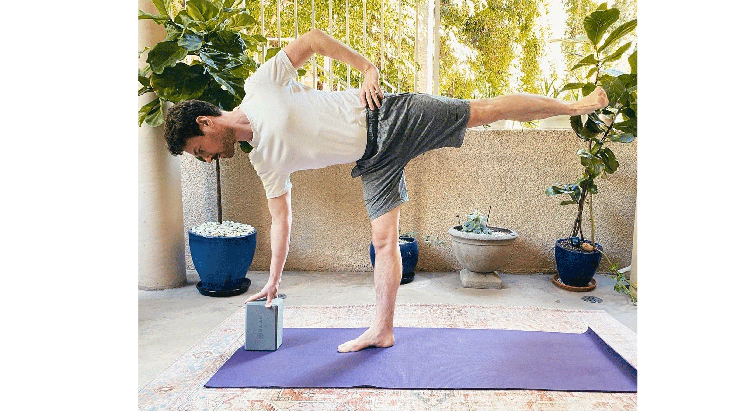
1. Half Moon Pose with a block
This variation can work well for anyone who has tight hamstrings.
Start in Extended Triangle Pose (Utthita Trikonasana) with your right foot facing forward. Place a block at its tallest height a couple of feet in front of your right foot. Bring your left hand to your left hip and bend into your right knee slightly. Reach your right hand to the block and begin to shift your weight forward into your right leg. As you straighten your right leg, begin to lift your left foot until your leg is horizontal and parallel to the mat. Turn the left side of your ribcage toward the ceiling to stack your shoulders. Either keep your left hand on your left hip or reach your left hand toward the ceiling. You have the option here to look down toward your right hand, straight ahead toward the left side of the room, or up toward the ceiling.
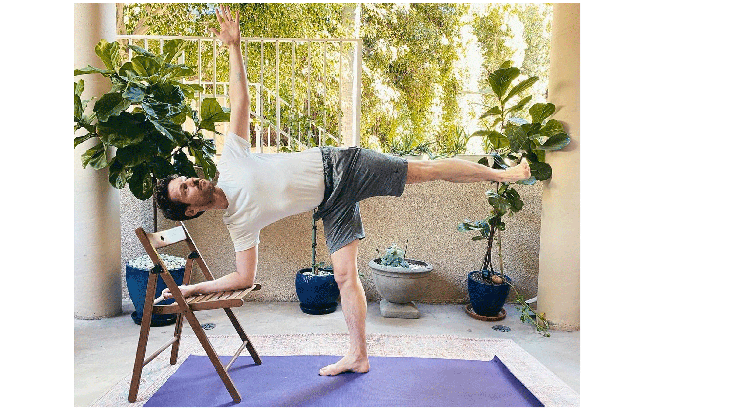
2. Half Moon Pose with a chair
This variation is an option for anyone who has tight hamstrings or struggles with their balance.
Start in Extended Triangle Pose (Utthita Trikonasana) with your right foot facing forward. Place a chair a few feet in front of your right foot with the chair seat facing you. Bring your left hand to your left hip, bend into your right knee, and place your right forearm onto the seat of the chair.
Shift your weight forward into your right leg as you straighten that leg and slowly lift your left foot until your leg is horizontal to the mat and parallel to the mat. Turn the left side of your ribcage toward the ceiling to stack your shoulders. Either keep your left hand on your left hip or reach your left hand toward the ceiling. You have the option here to look down toward the chair, to the left side of the room, or up toward the ceiling.
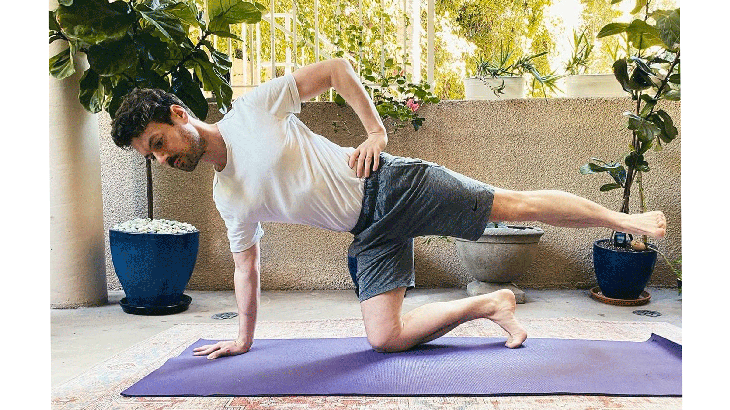
3. Half Moon Pose kneeling
This variation can work well for anyone who is recovering from a foot or ankle injury or struggling with their balance. It can also be helpful for someone who is new to the pose and is still learning to coordinate all the different actions.
Begin in Tabletop. You have the option to kneel on a folded blanket if this is more comfortable. Extend your left leg straight behind you with the ball of your foot on the mat. Shift your weight into your right hand, lift your left hand off the mat, and place it on your left hip.
Slowly lift your left foot until your leg is horizontal and parallel to the mat. Turn the left side of your ribcage toward the ceiling to stack your shoulders and either keep your left hand on your left hip or reach your left hand toward the ceiling. You have the option here to look down toward your right hand, to the left side of the room, or up toward the ceiling.
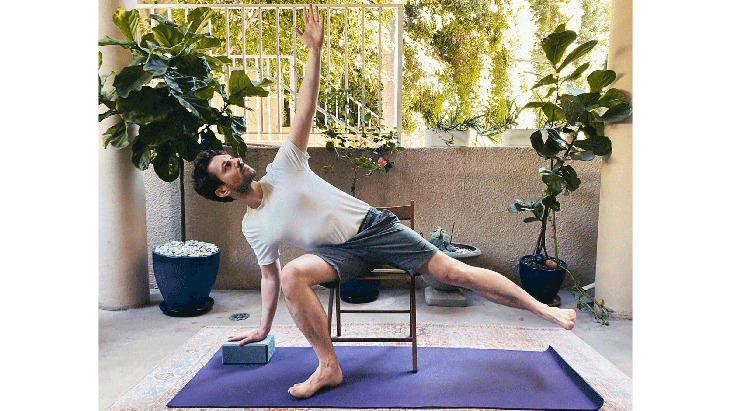
4. Seated Half Moon Pose
This variation is ideal for anyone who is working with a foot or ankle injury, struggles with their balance, or has issues rising from a seated position. Come to sit at the front edge of your chair and place a block a couple of feet away from the right side of the chair so that it is within reach. Step your right foot to the right about one foot and lean to the right to place your hand on the block. Place your left hand on your left hip.
Slowly lift your left foot out to the left side and straighten your leg, rotating your left hip externally until your left foot points up slightly. Turn the left side of your ribcage toward the ceiling to stack your shoulders and either keep your left hand on your left hip or reach your left hand toward the ceiling. You have the option here to look down toward your right hand, to the left side of the room, or up toward the ceiling.
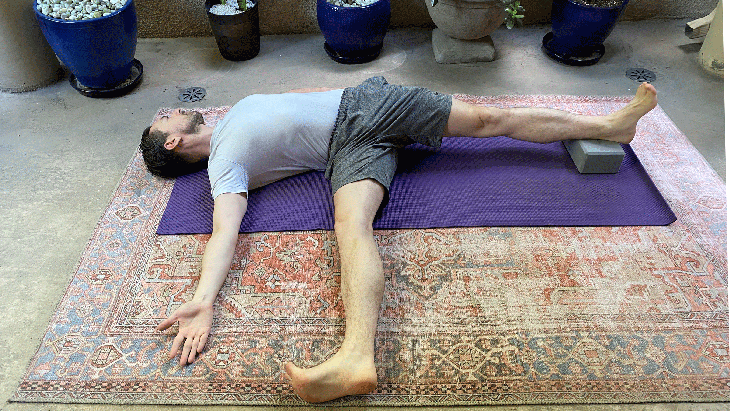
5. Reclining Half Moon Pose
If someone is working with a foot, ankle, or hip injury, or struggles with balance, this pose is a good option.
Lie on your right side with your legs straight and a block near your feet. Extend your right leg straight in front of you until it is perpendicular to your left leg and body. Flex your right foot. Place your left foot on the block and rotate your left hip externally until your left toes point up.
Extend your right arm straight in front of you and position it parallel to your right leg. Your right hand will reach toward the space a couple of feet in front of your right toes. Turn the left side of your ribcage back toward the mat. You may be able to rest both shoulder blades on the mat. Either keep your left hand on your left hip or reach your left hand back toward the mat. You have the option here to look toward your right hand, up to the ceiling, or toward the left side of your mat.
About our contributor
Andrew McGonigle has studied anatomy for more than 20 years. After initially studying to become a doctor, he moved away from Western medicine to become a yoga and anatomy teacher. He shares his knowledge of the body and the ways it moves in yoga teacher training courses throughout the world and leads his own Yoga Anatomy Online Course. His second book, The Physiology of Yoga, was published in June 2022. To learn more about Andrew, check out doctor-yogi.com or follow him on Instagram @doctoryogi.
For exclusive access to all of our fitness, gear, adventure, and travel stories, plus discounts on trips, events, and gear, sign up for Outside+ today.

